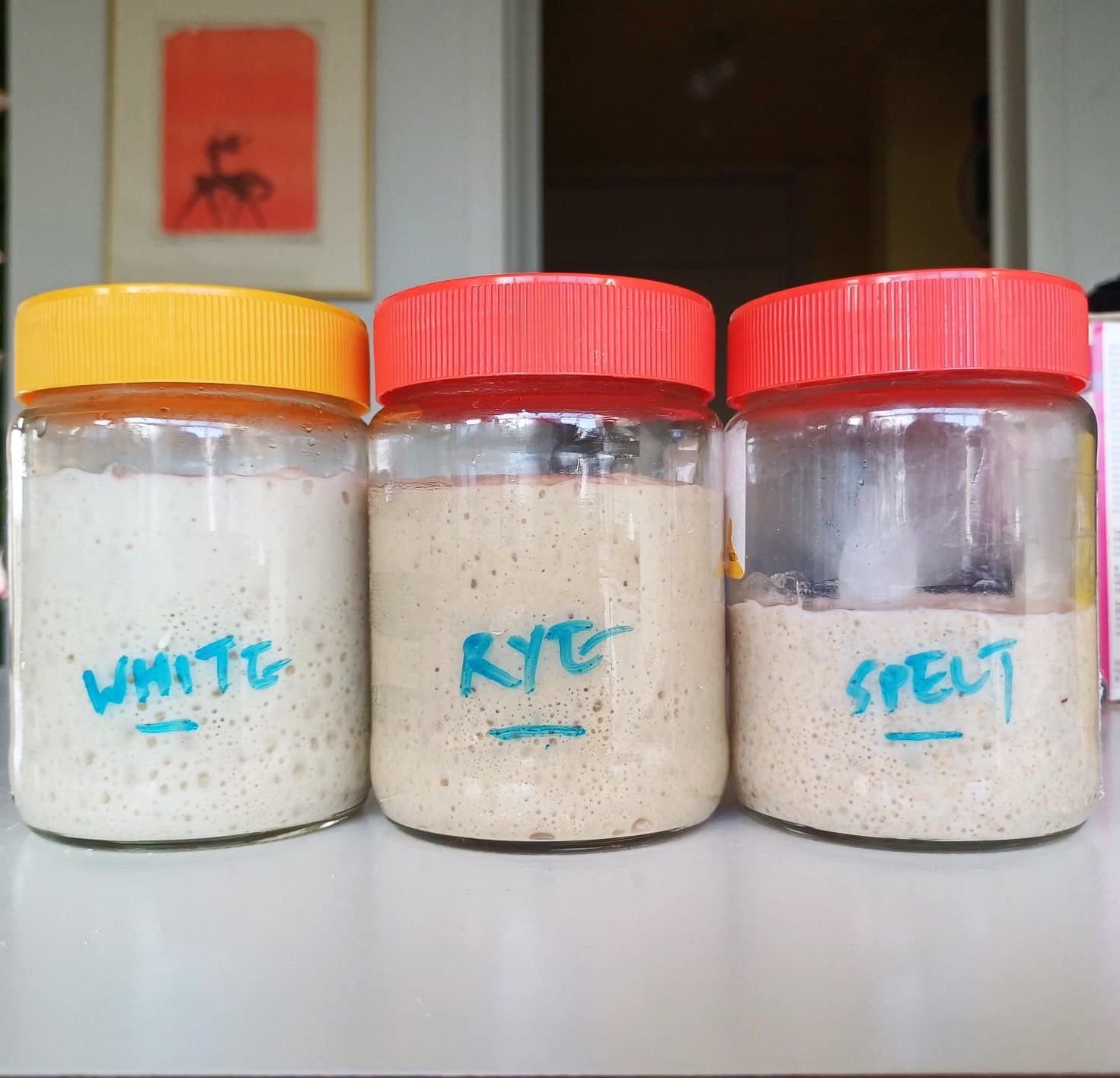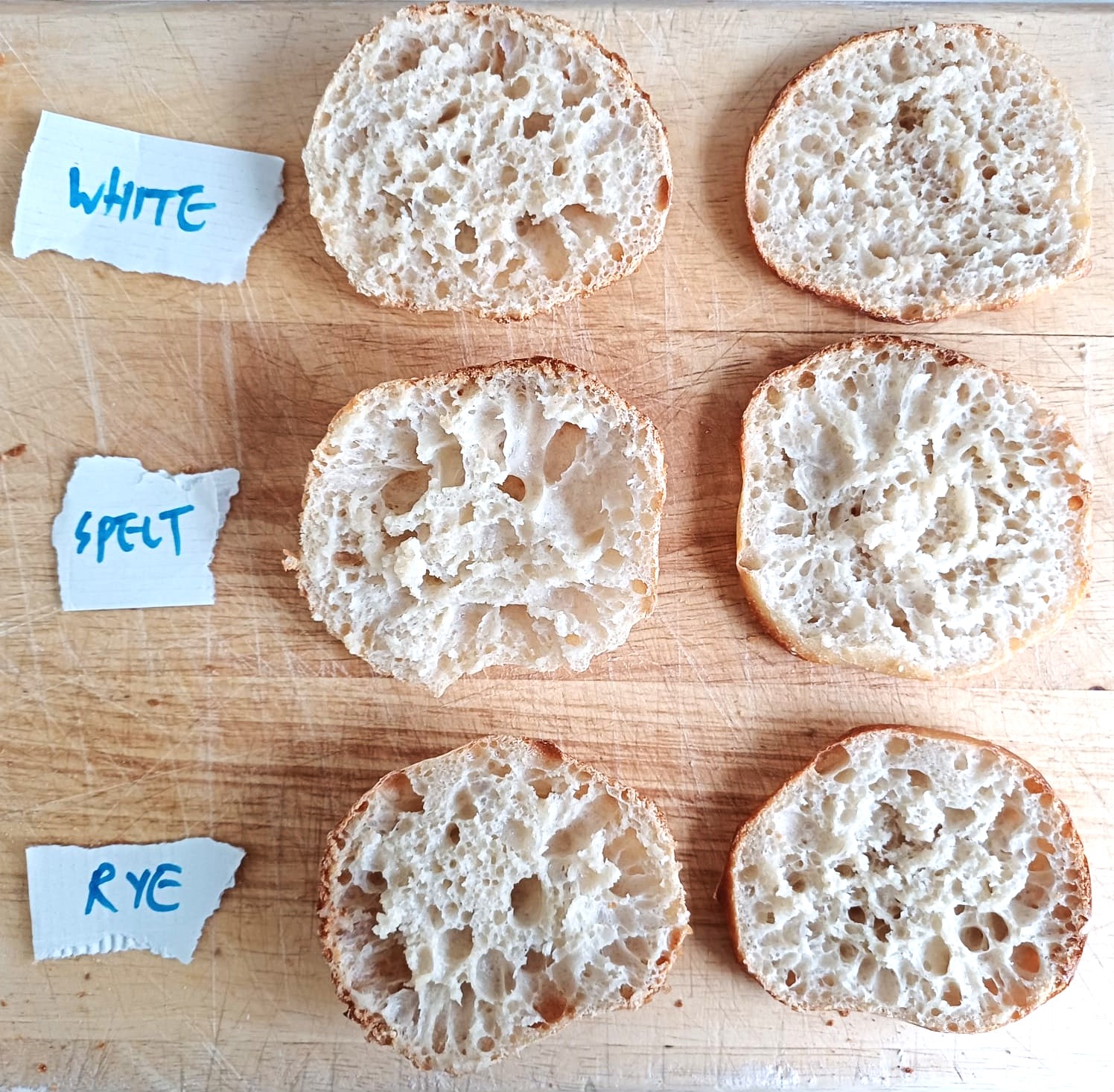
90% hydration ciabatta experiment with rye, spelt and white levains
Just wanted to share a fun experiment I did yesterday. Made three different levains overnight from my white-rye sourdough starter. All levains were 1:5:4 (starter, flour, water), but I changed the added flour for each levain: one had white AP, one had spelt, one had rye. In the morning, the white and rye had tripled, but the spelt only doubled (this surpised me). I proceeded to make mini ciabattas with the levains. From each levain, I made three mini ciabatta rolls, one with 15% levain, one with 30% levain, and one with 50% levain, all at 90% hydration, 1.5% salt, and added white bread flour. I expected the 50% levain rolls to fail due to acidic degradation of dough during BF. All ciabatta rolls survived! As you can all guess by now, the 50% levain rolls were the fastest to proof, followed by the 30% and finally the 15%. Interestingly, the rolls with white levain were consistently the slowest to rise (the 15% took 7 hours from BF to oven at room temp 23C). Spelt and rye levain rolls rose equally fast. I proceeded to get the husband to do a blind taste test of all 9 ciabatta rolls (more bread?! he said, lol) after they were baked and had cooled. He consistently preferred those made with the rye levain - lots of flavour, with the 30% only very mildly sour. This experiment really boosts my confidence to bake with rye or spelt levains at different proportions, especially if it's a same-day bake! Context: family likes spongy, springy bread with lots of flavour but very little sourness. That's why I'm experimenting with freshly made somewhat stiffer levains, limit BF time, have it happen between 18-22 C, and avoid cold retard. Next experiment will be a 40% rye levain walnut loaf. Crumb shot below of rolls with 15% levain 



Comments
A very interesting read. Fascinating too that you did this all with such a high hydration!
I guess you're going to have rye in your levain for the next while! Although, I was wondering that if you added a little rye when you made up the final dough if you'd have also ended up with something that came with extra husband approval.
-Jon
Very kind of you to comment! Yes - looks like rye is here to stay.
I used to add rye both to the levain and the main dough itself (resulting in a 30% rye loaf thereabouts), but I found that an equal amount in the starter created a more flavourful loaf with better crumb texture. Also, given the short BF+final proof timings without cold retard (to reduce sourness), I thought it best to keep whole grains in the levain for longer fermentation. Once I can more confidently ascertain how far to push the % of rye levain, I will start experimenting with adding other flavourful/nutritious components in the main dough.
Extra husband approval is going to take some time while I continue with experimentation! But at least we're getting somewhere. It used to be that his stomach could not tolerate anything with whole grain (conjecture is that the fibre in the whole grains need some breaking down). Sourdough bread has definitely improved that. I might also try using a long, cold autolyse for the main dough if I incorproate rye in it in future.
LL
Ah, that all makes sense.
If, and when, you're ready to try 50% rye in your bread then Eric's rye (here is Benny's take on it) makes a lovely bread.
-Jon
Thanks, Jon. Lots of reading to catch up on here. Will certainly try out Eric's rye. And Benny's take looks marvellous!
This morning I made two small loaves as a follow-up experiment, one that contained 50% rye levain, and another 40%. (Eric's dough contains 33% rye levain, or around 30% rye by flour content? Or have I got my math wrong.) Looking at the posts above I might be in for trouble, not having kneaded it much at all. Hydration was probably a little too high.
Let's see. Will slice them tonight and taste the results.
LL
Gosh, you're right, the rye is lower than I thought!
Very nice experiment! - though lots of work, especially to keep them all straight. Did you have a favorite of your own?
TomP
All the measuring and mixing did take me an hour! Maybe a wet ciabatta dough was not the best choice, on hindsight. But I just really like ciabatta.
I started the experiment thinking I would like the 15% white most. I used to make ciabatta with an overnight yeasted poolish and a same day rise of about 6-7 hours, so I thought the 15% would be the most similar in terms of crumb and flavour. But in the end I preferred those made with 30% levain most - it was a tie between the rye and the spelt, with the white in third place. The 30% simply offered sufficiently more flavour without any compromise on crumb structure. The 50% was good, but I found the flavour a little too much for what I'm used to in ciabattas.
I usually use starter instead of levain but in my mind there's not really much difference. You add some flour and water, and let it develop. Somehow I have converged on 30% starter in the dough, the same as you (not specific to ciabattas).
I generally use my starter directly, unless I need way more, or want to vary its composition, for experiments. I suppose it might be because I have a very small quantity of starter in my fridge, which I only refresh once a week.
Good to know that you too have settled on 30%. I tend to go with around 12-15% for an overnight 18-20 C rise, but prefer 30% if it's a 20-22 C same-day bake.
LL